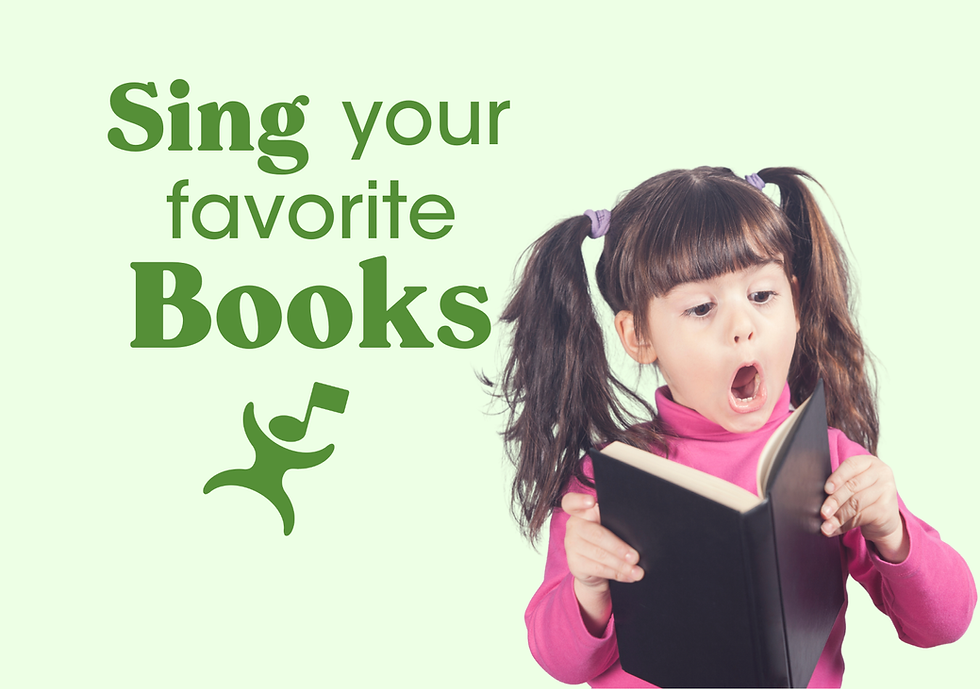Sing Your Favorite Books
- Let's Play Music

- Aug 15, 2024
- 3 min read
Updated: Nov 10

One of the favorite activities in every Sound Beginnings class is story time: It is a treasure reading picture books to children, and when we get to sing them, story time is even more valuable!
Why Read?
Parents and researchers are well aware of the myriad benefits of reading to young children. Reading to a child does so much:
increases his receptive (understood) vocabulary up to 40%
improves his expressive (speaking, talking) skills
prepares him to perform better in school
improves bonding and well-being
establishes a culture and pattern for enjoyment of reading
promotes communication between you and the child
instills positive attitudes toward reading and learning
promotes a longer attention span and develops abilities for focus and critical thinking
improves listening skills and imagination
expands his topical knowledge
raises his IQ by an average of 6 points

Why Sing?
It's no surprise, then, that we love incorporating story time into Sound Beginnings class. Singing the books adds even more boost.

Singing emphasizes rhymes, meter, and patterns in the language. We guide the child to notice and interpret them.
Melody provides a powerful memory tool. It's no wonder every brand has created a jingle for their product!
Music enhances the teaching of words, grammar, and concepts.
Singing boosts expressive language skills. Children practice using words and phrases in song lyrics that they have not quite yet mastered in everyday speaking.
Singing forces the brain to use both hemispheres simultaneously. We strengthen what we are learning by activating more of the brain as we learn.
To the Let's Play Music Students:
Singing stories also fosters creativity in composition. We often tell 3rd Year students that compositions can begin with anything, like a poem or rhyme.
Singing stories is not just for young children—it's a great way to explore music. You might even end up transcribing your new tunes and adding piano accompaniment to create a piece!
Sing-Along Storybooks
We have a whole series of storybooks created from songs - with high-spirited audio tracks to sing along! Children love if you sing these to them over and over while they look at the pictures and words. Watch a few on video here!
Your Favorite Books!

The library is full of charming books; wouldn't it be great if more were sing-alongs? You can transform them into songs with these tips:
Pick stories with repeating patterns and existing rhyme or meter (like Dr. Seuss).
Read the story several times to understand it.
Sing a page or two to test it out.
Even if your melody isn’t perfect, your preschooler will love it. Remember, learning happens through play, so don’t worry about being perfect. To enhance your song:
Choose a consistent melody for each story and stick with it.
Repeat the melody and story words frequently, as toddlers enjoy repetition.
Keep it simple. Use basic instruments or patterns, and try common melodic patterns like mi-re-do or sol-la-ti-do.
For an advanced challenge, create a meter and rhyme for stories without them.
The Composer in You
I hope you will try this idea of singing books a try. You will really be improving your composition skills and improvisation. Better yet, you'll be showing your children that we play with music. We don't just perform music that is written out in a score and practiced in rehearsal halls, we create music with the language around us, and we find the music hidden everywhere we go! It can be so silly.
You'll start to be aware of language: What melodic patterns fit these words? What rhythms do these words naturally have? Could I sing a tune to that phrase? You'll notice musical possibilities all around and expand your composing skills by bounds.



Pkv Games
DominoQQ Pkv BandarQQ
DominoQQ
Poker QQ
BandarQQ
Qiu Qiu
Pkv QQ
Poker Online
QiuQiu
Judi Bola
Parlay
10 Situs Judi QQ Online Terpercaya
Togel Kamboja
Scatter Hitam
DominoQQ Online
BandarQQ Login
Judi Bola Parlay
Slot Demo
Joker123
77 Rabbit
Bet88
Slot Maxwin
I love that bitcoin live baccarat Rakebit.com offers fun promotional angles on their live baccarat—welcome bonuses, reload perks, and even tournaments add extra spice. It’s not just the game itself, but the competitive edge they build with promotions that got me hooked. Bonuses definitely boosted my bankroll, giving me more playtime and more tries at getting close to nine. Combining that with my chosen strategy (often Martingale or D’Alembert) and clear rules, the whole experience felt rewarding and dynamic. It’s smart marketing, but also genuinely adds value for players like me.
Pkv games mereka main di situs rekomendasi ini dan beneran bisa ngerasain cuan harian. Keywords Terhubung :
Pkv Games Login DominoQQ Pkv BandarQQ Login Situs Pkv Games Qiu Qiu Online Pkv Resmi Domino99 Online Pkv Games Resmi Pkv QQ Resmi Domino Qiu Qiu Pkv Slot QQ Poker Pkv Server Pkv Games